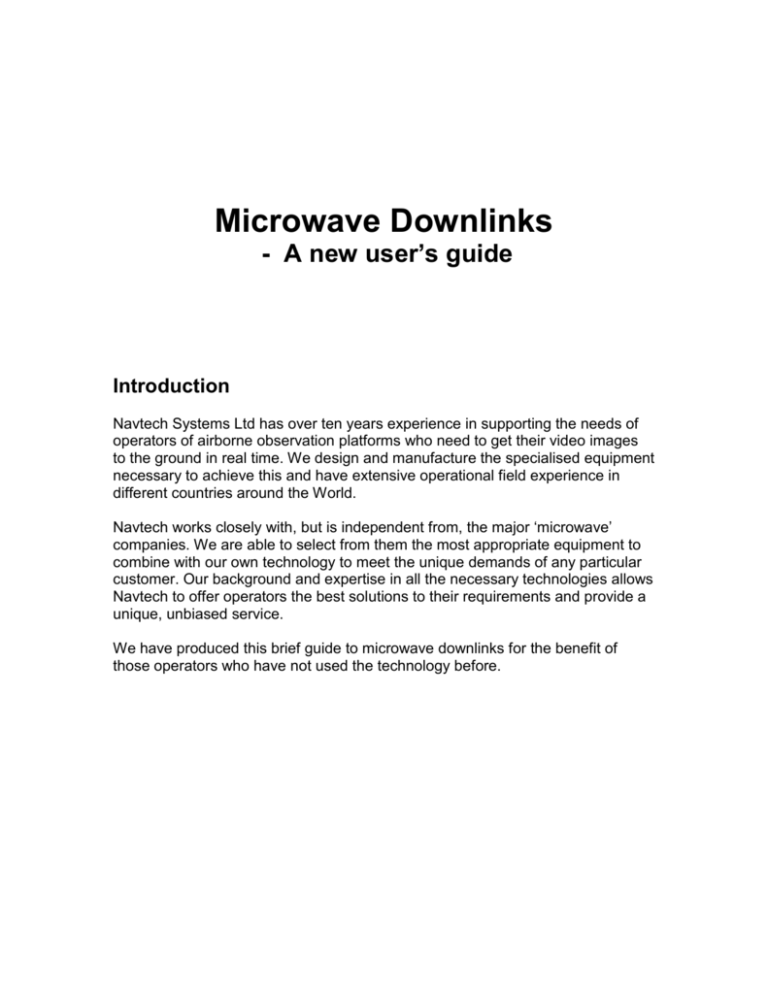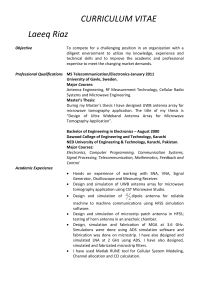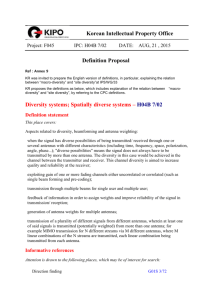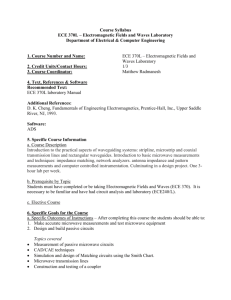Microwave Downlinks
advertisement

Microwave Downlinks - A new user’s guide Introduction Navtech Systems Ltd has over ten years experience in supporting the needs of operators of airborne observation platforms who need to get their video images to the ground in real time. We design and manufacture the specialised equipment necessary to achieve this and have extensive operational field experience in different countries around the World. Navtech works closely with, but is independent from, the major ‘microwave’ companies. We are able to select from them the most appropriate equipment to combine with our own technology to meet the unique demands of any particular customer. Our background and expertise in all the necessary technologies allows Navtech to offer operators the best solutions to their requirements and provide a unique, unbiased service. We have produced this brief guide to microwave downlinks for the benefit of those operators who have not used the technology before. Basic System Elements An air-to-ground video system contains the following items : Aircraft equipment 1. 2. 3. 4. 5. camera platform ( video source ) Telenav data encoder ( GPS into video ) microwave transmitter power supply ( DC/DC converter ) transmit antenna options : a) antenna actuator ( to deploy the antenna clear of the aircraft ) b) video encryption ( to enable ‘secure’ transmission ) c) LCD TFT video displays d) ‘permanent’ or ‘portable’ installations. Ground Equipment 1. 2. 3. 4. receive antenna(s) tracking platform ( for long range systems ) microwave receiver power supply ( mains or DC ) Options : a) b) c) d) e) signal boosters ( for long cable runs ) video monitors and distribution ( LCD or CRT ) video decryption moving map display ‘fixed’ or ‘portable’ installation Basic principles and equipment functions The equipment listed previously performs the following functions: Aircraft The airborne ‘camera’ provides a ‘standard’ video signal in PAL or NTSC format. This is fed to a data encoding system, developed by Navtech, called TELENAV, which ‘invisibly’ inserts digital data from a GPS receiver into the signal. The signal is thus ‘tagged’ with the position of the aircraft ( note that this system does not require the use of audio or other separate data channels – the data is carried ‘free’ and invisibly by the video signal at full transmission power ). If a ‘secure’ link is required then a video encryption unit ( ‘scrambler’ ) is added between the camera and the Telenav data encoder. The GPS - encoded signal is then fed to the microwave transmitter. Here the video signal is ‘added’ to the high power microwave ‘carrier’ signal that the transmitter generates, ready for transmission through the antenna. This antenna is normally an ‘omni-directional’ type, meaning that the signal is transmitted equally in all directions. ( For very long range operations a high gain, ‘directional’ system can be fitted to the aircraft ) Ground On the ground the signal is picked up by the receive antenna, either a simple omni-directional unit if operating over short ranges ( for example 1 to 5 miles ), or a high-gain, directional unit for long range operation ( in excess of 5 miles). If a directional antenna is used then a ‘tracking’ system is required to keep the antenna pointing towards the transmitting aircraft. Navtech has developed its own unique GPS-based system, called MICROTRACKER, for this purpose. The transmitted microwave signal passes from the receive antenna to the microwave receiver where the original video signal is ‘extracted’ from the ‘microwave carrier’. This is then ‘decrypted’ ( unscrambled ), if required, before passing to the Telenav decoder which forms part of the tracking system. This Telenav unit reads the encoded aircraft GPS positional data to enable the tracking platform to steer the antenna towards the aircraft. It also enables a unique software package (RTGIS ) to operate. This allows ground personnel to see the transmitted pictures alongside a moving map of the local area, with an icon indicating the position and track of the transmitting aircraft. The video signal is then free for normal distribution and display. Practical considerations : ‘Line of sight’ The most fundamental aspect concerning microwave linking is that the system is restricted to ‘line of sight’ operation. There must be a clear, unobstructed line between the transmitting and receiving antennas. Obstructions cause the signal to be interrupted resulting in picture ‘break-up’ or complete picture loss. Even trees ‘obstruct’ the signal. ‘Frequency’ The frequency of the microwave carrier transmission is generally determined by the ‘allocation’ dictated by the local authorities. For air-to-ground operations the frequencies most often used lie within the range 1.5GHz to 4.5GHz. Range performance ( assuming certain factors are fixed ) decreases with increasing frequency but so does the physical size of the necessary antennas. A good compromise is to operate in the region of 2.5GHz. ‘Range’ The range over which pictures will be successfully received depends on several factors : a) Transmitter power b) Microwave frequency c) Transmit antenna gain d) Receive antenna gain e) Receiver sensitivity f) Signal loss in cables and equipment g) Level of atmospheric attenuation and ‘path loss’ h) Definition of acceptable signal and picture quality ( general ‘surveillance’ operations can normally accept slightly lower levels than TV outside broadcasters ) With current technology and regulations, standard links can normally operate successfully up to 30 Miles ( but in certain circumstances, local conditions may reduce this ) and given appropriate conditions exceed this. ( Navtech has been involved in operations where pictures were received from in excess of 60 miles ). Operators must appreciate the way in which ‘local atmospheric’ conditions can alter the performance level of their system at the longer ranges. For ranges in excess of 30 miles careful consideration need to be given to equipment choice. ‘Installations’ Equipment can be provided in a form suitable for ‘permanent’ installation ( e.g. fixed, roof-top receive site ) or in ‘Pelicases’ for portable, rapid deployment situations. In all cases, it is important to minimise the lengths of microwave (rf) interconnecting cable to keep signal loss to a minimum. The mounting of the transmit antenna on the aircraft can have a significant effect on overall system performance. Aircraft type determines what is actually possible, but as a general rule performance is increased by mounting the antenna on an ‘actuator’. This device is used when in flight to ‘deploy’ the antenna beneath the aircraft on the end of a ‘pole’, so that it is clear of the aircraft underside and skids / undercarriage. This allows the signal to be transmitted ‘unrestricted’ and allows a degree of flexibility in the banking manoeuvres that the aircraft can perform without signal break-up. ‘Antenna gain’ Antennas are not ‘active’ devices i.e. they do not increase the actual power level of the signal. The term ‘gain’ sometimes leads to confusion – it simply refers to the ability of ‘directional’ antennas to behave as if there is a ‘stronger’ signal : A standard omni-directional antenna, as implied by its name, operates in all directions. Thus for example 1W of input power is spread over a wide area. If a directional antenna is used then this 1W can all be ‘focused’ in one direction. The gain of the antenna refers to the effective increase in input power level necessary for an omni-directional antenna to provide the same effective signal strength at a fixed receive measurement point. On the transmit side of the link a directional antenna would enable the transmitted energy to be ‘sent’ in a particular direction only, thereby maximising efficiency and link performance. On the receive side, a high gain directional antenna gives a higher received signal output level for a given transmitted signal strength compared to a zero-gain omni antenna, but only when directed towards the transmitting source. Directional antennas also have the significant benefit of minimising ‘multi-path’ interference ( caused by signal reflections from buildings for example ). ‘Polarisation’ Microwave antennas are normally ‘polarised’ which means that the transmitted signal is of a particular ‘orientation’ . For downlinks, ‘circular’ polarisation is generally used ( either Right-Hand or Left-Hand ). The transmit and receive antennas need to match for effective operation – one of the advantages of circular polarisation is that any signal that gets ‘reflected’ from an obstruction has its polarisation reversed in the process. This reflected signal will then not match the receive antenna orientation, thereby further minimising ‘multi-path’ interference. ‘Power’ The more power that is transmitted, the greater the range that can be achieved. Power amplifiers are available up to approximately 40W. However costs escalate significantly when range requirements increase beyond about 50 miles. In many cases range performance is effectively limited by restrictions placed on transmitted power levels by government authorities ( ‘ERP’ levels ). Questions and advice Navtech engineers are always willing to answer any questions and give advice or guidance on air-to-ground linking systems. In this specialised area, we are independent and unbiased, with the goal of providing the system operator with the best possible levels of performance and service. Contact details : UK : Navtech Systems Ltd The Hollies Naseby Road Clipston Market Harborough Leicestershire LE16 9RZ USA : Navtech Systems (USA) Ltd 3181 Kinross Circle Herndon Virginia 20171 USA tel : +44 (0)1858 525454 fax : +44 (0)1858 525462 e-mail: sales@navech.demon.co.uk tel : + (703) 478 3250 fax: + (703) 478 3252



